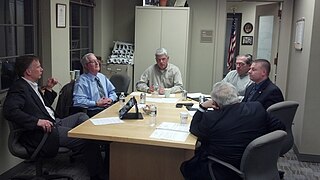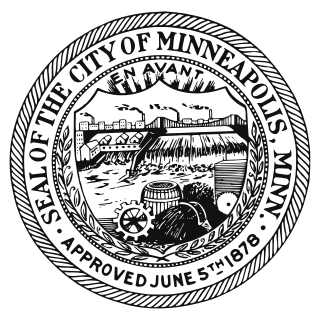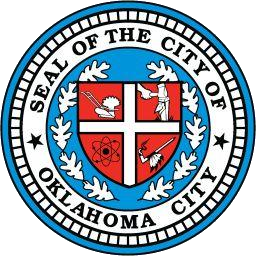Related Research Articles
In many countries, a mayor is the highest-ranking official in a municipal government such as that of a city or a town. Worldwide, there is a wide variance in local laws and customs regarding the powers and responsibilities of a mayor as well as the means by which a mayor is elected or otherwise mandated. Depending on the system chosen, a mayor may be the chief executive officer of the municipal government, may simply chair a multi-member governing body with little or no independent power, or may play a solely ceremonial role. A mayor's duties and responsibilities may be to appoint and oversee municipal managers and employees, provide basic governmental services to constituents, and execute the laws and ordinances passed by a municipal governing body. Options for selection of a mayor include direct election by the public, or selection by an elected governing council or board.

The government of New York City, headquartered at New York City Hall in Lower Manhattan, is organized under the New York City Charter and provides for a mayor-council system. The mayor is elected to a four-year term and is responsible for the administration of city government. The New York City Council is a unicameral body consisting of 51 members, each elected from a geographic district, normally for four-year terms. Primary elections for local offices use ranked choice voting, while general elections use plurality voting. All elected officials are subject to a two consecutive-term limit. The court system consists of two citywide courts and three statewide courts.

The select board or board of selectmen is commonly the executive arm of the government of New England towns in the United States. The board typically consists of three or five members, with or without staggered terms. Three is the most common number, historically.

Honolulu City Council is the legislature of the City and County of Honolulu, the capital and largest city in Hawai'i, the fiftieth state in the United States. The City and County of Honolulu is a municipal corporation that manages government aspects traditionally exercised by both municipalities and counties in other states. Each of the nine members of its city council is elected to a four-year term and can serve no more than two consecutive terms. Council members are elected by voters in nine administrative districts that, since 1991, are reapportioned every ten years. Like the Honolulu mayor, members of the city council are elected via nonpartisan elections.

The Los Angeles City Council is the lawmaking body for the city government of Los Angeles, California, the second largest city in the United States. It has 15 members who each represent the 15 city council districts that are spread throughout the city's 501 square miles of land.

The Minneapolis City Council is the legislative branch of the city of Minneapolis in Minnesota, United States. Comprising 13 members, the council holds the authority to create and modify laws, policies, and ordinances that govern the city. Each member represents one of the 13 wards in Minneapolis, elected for a four-year term. The current council structure has been in place since the 1950s.

The Council of the District of Columbia is the legislative branch of the government of the District of Columbia. As permitted in the United States Constitution, the district is not part of any U.S. state and is overseen directly by the federal government.

The New York City Council is the lawmaking body of New York City in the United States. It has 51 members from 51 council districts throughout the five boroughs.
The Optional Municipal Charter Law or Faulkner Act provides New Jersey municipalities with a variety of models of local government. This legislation is called the Faulkner Act in honor of the late Bayard H. Faulkner, former mayor of Montclair, New Jersey and chairman of the Commission on Municipal Government.
A municipal council is the legislative body of a municipality or local government area. Depending on the location and classification of the municipality it may be known as a city council, town council, town board, community council, rural council, village council, or board of aldermen.

The government of the U.S. State of Oklahoma, established by the Oklahoma Constitution, is a republican democracy modeled after the federal government of the United States. The state government has three branches: the executive, legislative, and judicial. Through a system of separation of powers or "checks and balances," each of these branches has some authority to act on its own, some authority to regulate the other two branches, and has some of its own authority, in turn, regulated by the other branches.
The government in Dallas, Texas is primarily vested in the Dallas City Council, Mayor, and City Manager. There is also the Dallas Police Department, Dallas Fire-Rescue, and the Dallas municipal courts. In the 2006–2007 fiscal year, the city's total budget was $2.3 billion.
A mayor–council government is a system of local government in which a mayor who is directly elected by the voters acts as chief executive, while a separately elected city council constitutes the legislative body. It is one of the two most common forms of local government in the United States, and is the form most frequently adopted in large cities, although the other common form, council–manager government, is the local government form of more municipalities.

The City of Muskogee is governed by a city manager, mayor and a city council under the council–manager form of local government. The governing document of Muskogee, Oklahoma is the City Charter of Muskogee.

The San Diego City Council is the legislative branch of government for the city of San Diego, California. The city council was first established in San Diego in 1850. The council uses a strong mayor system with a separately elected mayor who acts as the executive. There are currently nine members of the council. City council members serve a four-year term and are limited to two successive terms.
Patience Sewell Latting was an American politician who served as Mayor of Oklahoma City, Oklahoma, from 1971 to 1983. Latting was the first female Mayor of Oklahoma City.

The Oklahoma City Council is the unicameral legislative body of the City of Oklahoma City, Oklahoma. The form of government of Oklahoma City is a council-manager government, therefore the mayor is included as a member of the city council. The current mayor is David Holt. The mayor serves as President of the Council and presides over all council meetings. The city council must set policy, enact ordinances, and authorize expenditures of City funds. Although the council is nonpartisan, six of the nine members are associated with the Republican Party.
The following table lists the individuals who served as mayor of Hartford, Connecticut, their political party affiliations, and their dates in office, as well as other information.

The 2022 Oklahoma City mayoral election took place on February 8, 2022, to elect the Mayor of Oklahoma City. Incumbent Republican Mayor David Holt won re-election outright with 59.8% of the vote, eliminating the need for a runoff.
References
- ↑ https://www.okc.gov/home/showpublisheddocument/3584/636754565676000000%7Ctitle=%5B%5D Guide to City Government
- ↑ "News List | City of OKC".
- ↑ "City Manager | City of OKC".
- ↑ "FY 2022 Budget | City of OKC".
- ↑ "About City Manager Craig Freeman | City of OKC".
- ↑ "Pay raises OK'd; MAPS planning progresses | the Journal Record". 24 November 2021.
- ↑ "FTC Oklahoma City." Federal Bureau of Prisons. Retrieved on February 21, 2011.